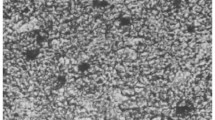The uniformity of the structure of porcelain articles in terms of the orientation of the quartz particles (grains) and the distance between them was evaluated by means of optical microscopy. The distributions of the number of quartz grains along the maximum horizontal and vertical dimensions as well as the distribution of minimum intergrain distances along the vertical and horizontal directions, which are influenced by the different orientation of the particles in the material and the uniformity of the volume distribution of the material particles, were obtained. The deviations of local distributions from the base distributions make it possible to evaluate the structural uniformity of the investigated materials and articles and to analyze the effect of the molding method on their structural features.





Similar content being viewed by others
References
Yu. N. Kryuchkov, “Homogeneity control in heterogeneous materials,” Steklo Keram., No. 1, 15 – 17 (2000); Yu. N. Kryuchkov, “Homogeneity control in heterogeneous materials,” Glass Ceram., 57(1 – 2), 14 – 17 (2000).
A. I. Zakharov, “Homogeneity of ceramics: correlation with molding method and geometric parameters of articles,” Steklo Keram., No. 9, 35 – 38 (2003); A. I. Zakharov, “Homogeneity of ceramics: correlation with molding method and geometric parameters of articles,” Glass Ceram., 60(9 – 10), 287 – 290 (2003).
Yu. N. Kryuchkov, Structure and Nonlinear Structural Effects of Permeable and Composite Materials [in Russian], GGKhPI, Gzhel (2006).
T. L. Neklyudova and G. N. Maslennikova, “Structural particulars of porcelain articles manufactured by slip casting,” Steklo Keram., No. 2, 16 – 19 (2011); T. L. Neklyudova and G. N. Maslennikova, “Structural particulars of porcelain articles manufactured by slip casting,” Glass Ceram., 68(1 – 2), 52 – 55 (2011)
E. S. Golubtsova and B. A. Kaledin, Statistical Methods of Investigation of Structural Ceramics [in Russian], UP “Tekhnoprint,” Minsk (2004).
R. Hillebrand, “Slip optimization by use of additives explained with an example of a conventional sanitaryware body,” Berichten DKG, 90(1, 2), 51 – 56 (2013).
T. L. Neklyudova and A. I. Zakharov, “Influence of the molding method on the structure of porcelain articles,” Steklo Keram., No. 7, 28 – 33 (2013); T. L. Neklyudova and A. I. Zakharov, “Influence of the molding method on the structure of porcelain articles,” Glass Ceram., 70(7 – 8), 260 – 264 (2013).
Author information
Authors and Affiliations
Corresponding author
Additional information
Translated from Steklo i Keramika, No. 10, pp. 19 – 23, October, 2016.
Rights and permissions
About this article
Cite this article
Kryuchkov, Y.N., Neklyudova, T.L. Structural Uniformity of Porcelain Articles. Glass Ceram 73, 369–373 (2017). https://doi.org/10.1007/s10717-017-9891-6
Published:
Issue Date:
DOI: https://doi.org/10.1007/s10717-017-9891-6




